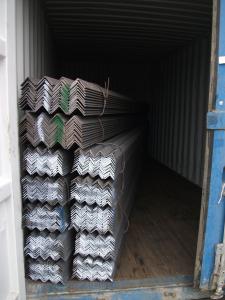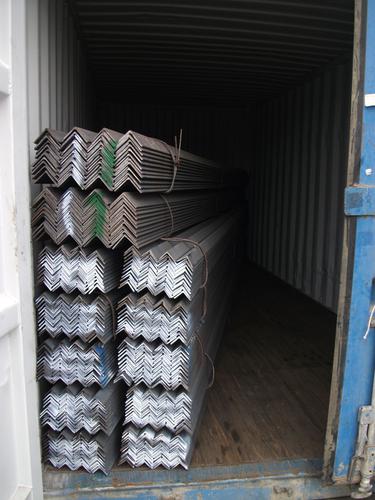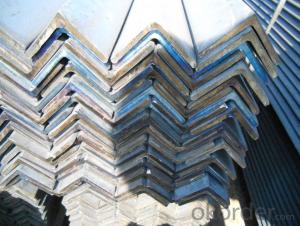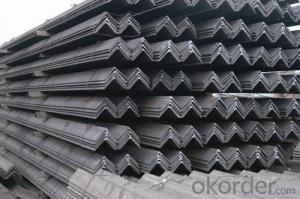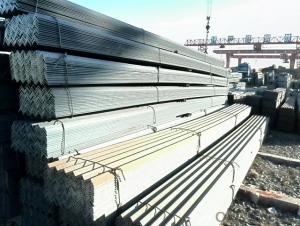Equal Angle Steel Bar
- Loading Port:
- China Main Port
- Payment Terms:
- TT OR LC
- Min Order Qty:
- -
- Supply Capability:
- -
OKorder Service Pledge
OKorder Financial Service
You Might Also Like
Specifications of Angle Steel
1. Invoicing on theoretical weight or actual weight as customer request.
2. Length: 6m, 9m, 12m.
3. Sizes:
| Size(mm) | Mass(Kg/m) | Size(mm) | Mass(Kg/m) |
| 50*50*4 | 3.059 | 63*63*5 | 4.822 |
| 50*50*5 | 3.77 | 63*63*6 | 5.721 |
| 50*50*6 | 4.465 | | |
Payment terms:
1).100% irrevocable L/C at sight.
2).30% T/T prepaid and the balance against the copy of B/L.
3).30% T/T prepaid and the balance against L/C.
Material details:
Alloy No | Grade | Element (%) | | ||||
C | Mn | S | P | Si | | ||
| | |||||||
|
|
|
|
|
|
| |
Q235 | B | 0.12—0.20 | 0.3—0.7 | ≤0.045 | ≤0.045 | ≤0.3 | |
|
|
|
|
|
|
| |
Alloy No | Grade | Yielding strength point( Mpa) | | ||||
Thickness (mm) | | ||||||
≤16 | >16--40 | >40--60 | >60--100 | | |||
≥ | | ||||||
|
|
|
|
|
| | |
Q235 | B | 235 | 225 | 215 | 205 | | |
Alloy No | Grade | Tensile strength (Mpa) | Elongation after fracture (%) | | |||
Thickness (mm) | | ||||||
| ≤16 | >16--40 | >40--60 | >60--100 | | ||
≥ | | ||||||
|
|
|
|
|
|
| |
Q235 | B | 375--500 | 26 | 25 | 24 | 23 | |
*If you would like to get our price, please inform us the size, standard/material and quantity. Thank you very much for your attention.
- Q: Can steel angles be used as bracing elements in a structure?
- Yes, steel angles can be used as bracing elements in a structure. Steel angles are commonly used in construction as they provide excellent strength and stability. When used as bracing elements, steel angles can effectively resist lateral forces and prevent structural deformation or collapse. They are often used to provide additional support and stability to structural members, such as beams or columns, by connecting them together at specific angles. Steel angles can be easily fabricated and installed, making them a versatile and cost-effective choice for bracing elements in various types of structures, including buildings, bridges, and industrial facilities.
- Q: What is the fire resistance rating of steel angles?
- The fire resistance rating of steel angles depends on various factors such as the size and thickness of the angle, the type of steel used, and the specific fire protection measures implemented. Steel is inherently fire-resistant due to its high melting point and low thermal conductivity. However, the fire resistance rating can be enhanced by applying fireproofing materials, such as intumescent coatings or fire-resistant boards, to the steel angles. These fire protection measures can significantly increase the fire resistance rating of steel angles by providing insulation and slowing down the transfer of heat to the steel. The specific fire resistance rating can vary based on the thickness and type of fireproofing materials used. For example, a steel angle with a certain fireproofing coating may have a fire resistance rating of 60 minutes, meaning it can withstand exposure to fire for up to 60 minutes before losing its structural integrity. It is important to consult local building codes, regulations, and fire safety standards to determine the specific fire resistance requirements for steel angles in a particular application. These standards can provide guidance on the necessary fire protection measures and the minimum fire resistance ratings that need to be met in different construction scenarios.
- Q: What are the different types of steel angles used in storage tank construction?
- Storage tank construction commonly utilizes several different types of steel angles, each serving a crucial role in providing structural support and stability. 1. L-angles, also referred to as unequal angles, find wide usage in storage tank construction. Comprising one longer and one shorter side, these angles form an L-shape. They are frequently employed as tank stiffeners, effectively preventing deformation and maintaining structural integrity. 2. T-angles, alternatively known as tee angles, represent another type of steel angle employed in storage tank construction. With a T-shape, one side is long while the other is shorter and perpendicular. T-angles often function as horizontal and vertical bracing members within tank structures, delivering added strength and stability. 3. Equal angles, also called right angles, consist of two equal sides forming a 90-degree angle. Tank construction commonly utilizes equal angles in various applications, such as providing support for tank roofs, reinforcing corners, or connecting tank components. 4. Bulb angles, or bulb flats, boast a unique shape featuring a flat surface and a bulbous section at one end. These angles are frequently employed in tank support structures, notably the tank bottom, to evenly distribute loads and minimize stress concentrations. 5. Rolled steel sections, such as I-beams, channels, and H-beams, are additionally utilized in storage tank construction alongside the aforementioned angle types. Rolled steel sections offer supplementary strength and support to tank structures, particularly in larger tanks or areas with high load requirements. In summary, the choice of steel angles in storage tank construction hinges upon specific design requirements, load considerations, and structural integrity needs. Selecting the appropriate type and size of angles is crucial to ensure tanks can withstand anticipated loads and environmental conditions.
- Q: What are the limitations of using steel angles?
- There are several limitations associated with the use of steel angles in various applications. Firstly, steel angles have a limited load-bearing capacity. The weight and pressure that can be safely supported by a steel angle are determined by its size, shape, and material composition. If the load exceeds the weight-bearing capacity of the angle, it can lead to structural failure or deformation. Secondly, steel angles are susceptible to corrosion. They are typically made of carbon steel, which can rust over time when exposed to moisture or corrosive environments. This corrosion weakens the structural integrity of the angle, reducing its lifespan and potentially compromising the overall stability of the structure it supports. Additionally, steel angles may have limitations in terms of their flexibility and versatility. Due to their fixed shape and size, they may not be suitable for applications that require intricate or complex designs. In such cases, alternative materials or fabrication methods may be more appropriate. Another limitation of steel angles is their limited resistance to fire. Steel, including steel angles, loses its strength and structural integrity at high temperatures. In the event of a fire, steel angles may not be able to withstand the heat and can deform or collapse, jeopardizing the safety of the structure and its occupants. Lastly, steel angles can be challenging to work with during installation or modification. Their rigid nature may require specialized tools, equipment, or expertise for cutting, drilling, or welding. This can add to the overall cost and time required for construction or renovation projects. Despite these limitations, steel angles remain widely used in various industries due to their affordability, durability, and versatility within their design limits. However, it is essential to consider these limitations and evaluate the specific requirements of each application to determine if steel angles are the most suitable choice.
- Q: How do steel angles perform under dynamic loads?
- Steel angles generally perform well under dynamic loads due to their inherent strength and durability. The structural shape of steel angles, characterized by their L-shaped cross-section, provides excellent resistance to bending and torsional forces. This design allows them to efficiently distribute dynamic loads and resist deformation, making them suitable for various applications in construction, engineering, and manufacturing industries. However, the specific performance of steel angles under dynamic loads can vary depending on factors such as the grade and quality of the steel, the magnitude and frequency of the dynamic load, and the overall design and reinforcement of the structure.
- Q: Can steel angles be used in bridge construction?
- Certainly, steel angles are an essential component in the construction of bridges. Known as L-shaped structural steel, they serve as crucial cross-sectional supports in bridge construction. Their ability to provide stability, strength, and rigidity makes them highly valuable in bridge structures. Steel angles exhibit versatility, making them suitable for different bridge elements like beams, trusses, and bracing systems. To ensure the integrity and load-carrying capacity of the bridge, these angles are often welded or bolted together to create structural connections. The advantages of steel angles in bridge construction include a high strength-to-weight ratio, durability, and resistance to corrosion. As a result, steel angles are widely relied upon and used in the construction of bridges.
- Q: How do you calculate the bending capacity of a steel angle?
- To calculate the bending capacity of a steel angle, you need to determine the moment of inertia of the angle section and the maximum allowable stress. The moment of inertia is calculated using the dimensions of the angle section, and the maximum allowable stress is typically provided by the steel manufacturer. By applying these values to the appropriate bending equation, you can calculate the bending capacity of the steel angle.
- Q: What are the different types of steel angle profiles?
- There are several different types of steel angle profiles, including equal angle, unequal angle, L-shaped angle, and structural angle. Each profile has its own specific dimensions and uses in various applications.
- Q: What is the cost of steel angles compared to other structural materials?
- The cost of steel angles compared to other structural materials can vary depending on factors such as the specific type of material, market conditions, and quantity needed. However, generally speaking, steel angles tend to be a cost-effective choice for structural applications due to their durability, strength, and versatility.
- Q: How many meters is one angle steel?
- Angle called angle, the steel strip is perpendicular to each other on both sides into the corner. There are equal angles and unequal angles. The two sides of an equal angle steel are equal in width. The specifications are expressed in millimeters of edge width * edge width * edge thickness. Such as "/ 30 x 30 x 3", that is 30 mm width equal angle, edge thickness of 3 mm. Also available models that model is the number of centimeters wide, such as angle 3#. The model does not mean the size of the different edges and sizes of the same model. Therefore, the width, the edge and the thickness of the angle iron should be filled out in the contract and other documents, so as not to be indicated by the model alone.
Send your message to us
Equal Angle Steel Bar
- Loading Port:
- China Main Port
- Payment Terms:
- TT OR LC
- Min Order Qty:
- -
- Supply Capability:
- -
OKorder Service Pledge
OKorder Financial Service
Similar products
Hot products
Hot Searches
Related keywords
